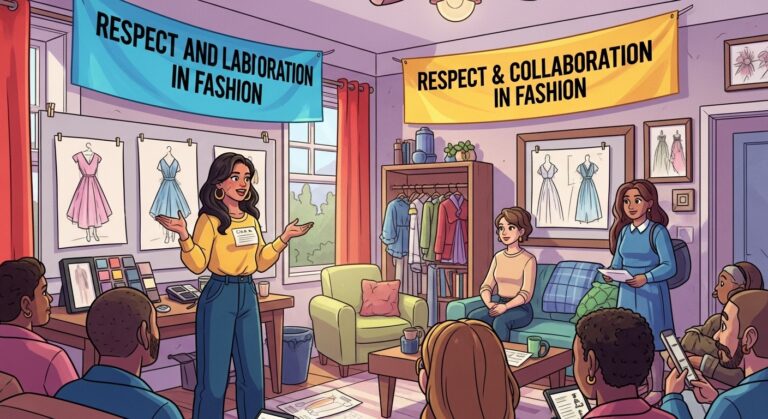In the vibrant world of fashion, where creativity flourishes and dreams are sewn into fabric, there lies a realm of trust between creators and their patrons. This story revolves around a young woman named Clara, a 29-year-old fashion enthusiast with a discerning eye for unique designs. Clara had her heart set on a summer dress that she preordered from a rising independent designer, Sophie, who was known for her innovative approach to fashion.
Clara discovered Sophie’s designs in the early months of the year, drawn to the whimsical patterns and distinctive cuts that spoke to her personal style. After browsing through Sophie’s portfolio online, Clara knew she had to have one of her creations. So, she placed an order for a custom dress, making a few minor alterations to ensure it would fit her perfectly. She paid the full amount upfront, excitedly anticipating the arrival of her unique piece.
As the months rolled by, Clara found herself daydreaming about the dress—its soft fabric swirling around her as she danced at summer gatherings, the compliments she would receive from friends, and the confidence it would instill in her. Sophie had announced that she was only taking a limited number of orders—about twenty—and Clara felt privileged to be one of the chosen few.
August arrived, and Clara, growing eager, reached out for an update. Sophie responded with a reassuring message, stating that the dress would be ready in two weeks. Clara was understanding; after all, handmade items often require time and care. She knew that good things come to those who wait.
However, as September dawned, Clara noticed something curious. Sophie began posting sneak peeks of her latest designs on social media, showcasing vibrant colors and intricate details. One afternoon, while scrolling through her feed, Clara’s heart sank. There it was—the dress she had eagerly awaited, worn by a model in a professional photoshoot. She recognized every stitch, every hue, and every detail. But there was no mention of shipment or her name. It seemed that her custom dress had morphed into a marketing tool, used to promote Sophie’s brand without her consent.
Days turned into weeks, and just as Clara was beginning to accept the bewildering circumstances, she stumbled upon a video interview featuring Sophie. In the video, Sophie wore Clara’s dress, showcasing it to the camera with pride. The moment Clara saw her creation parading on screen, a wave of betrayal washed over her. How could someone she trusted turn her dream into a public spectacle without even asking?
Upset and confused, Clara decided to confront Sophie. She sent an email, articulating her feelings of disappointment. She expressed how important the dress was to her—not just as an item of clothing, but as a symbol of her individuality and a reflection of her trust in Sophie’s craftsmanship. To her dismay, Sophie replied, explaining that she had chosen to feature the dress in the interview as a way to generate excitement about her brand. Clara felt her heart drop further; this was not the answer she had hoped for.
Clara wrestled with her emotions. She had been supportive, patient, and understanding throughout the entire process, and yet here she was, feeling like a mere afterthought in Sophie’s marketing strategy. The lack of consent felt like a violation of their agreement, and Clara couldn’t help but wonder if her excitement for the dress had been misplaced.
In the weeks that followed, Clara’s initial disappointment began to transform into resolve. She realized she had a choice to make. Should she continue to feel hurt and betrayed, or could she reclaim her power in this situation? After much contemplation, Clara decided that she would not allow this incident to define her experience with fashion and creativity.
With a newfound sense of purpose, Clara reached out to her community of friends and fellow fashion lovers. She shared her story, not as a tale of woe, but as an example of the importance of consent and respect in creative industries. To her surprise, her vulnerability resonated with many, and she found herself surrounded by a supportive network of individuals who had faced similar dilemmas.
Encouraged by the response, Clara organized a small event at a local community center, inviting independent designers and fashion enthusiasts to come together. The theme of the event was “Respect and Collaboration in Fashion.” Clara shared her story as a case study, discussing how essential it is for designers to communicate openly with their clients and how clients, in turn, should feel empowered to express their needs and concerns.
Sophie, upon hearing about Clara’s event, reached out to her with an apology. She admitted that she had acted thoughtlessly and acknowledged the importance of respecting her clients’ ownership of their designs. Clara, recognizing the sincerity in Sophie’s words, agreed to meet and discuss how they could work together to prevent similar situations in the future.
The event ultimately blossomed into a movement within the local fashion community, encouraging mutual respect and understanding. Clara’s story became a catalyst for change, fostering a culture where both designers and clients could collaborate freely, ensuring that the magic of fashion was preserved and celebrated.
And so, in a twist of fate, what began as a tale of betrayal transformed into a narrative of empowerment and community. Clara not only reclaimed her sense of self but also inspired others to stand firm in their beliefs and advocate for their rights in the creative world.





0 Comments